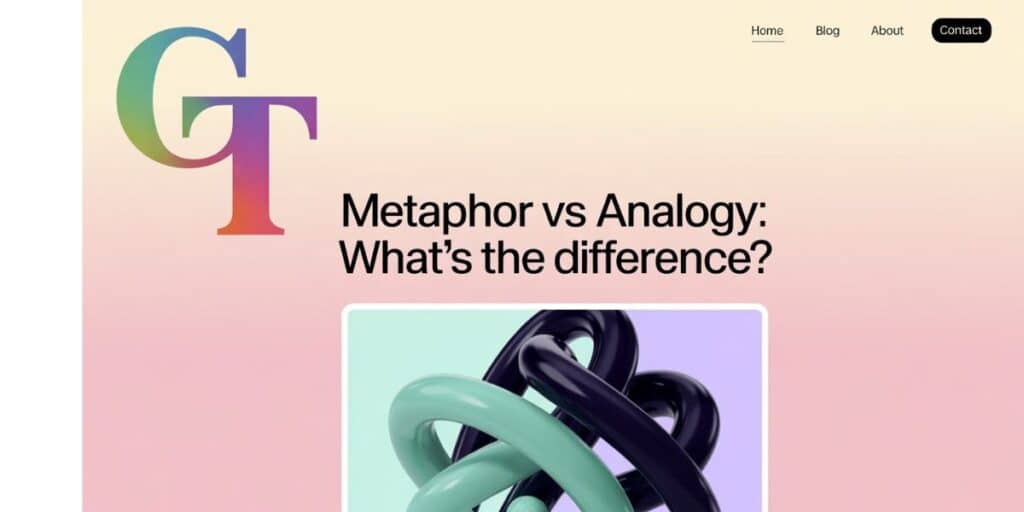Metaphor vs Analogy: What’s the Difference? This age-old question often serves as a cause of great perplexity among writers, students, and curious minds. Both figurative languages are really helpful in communicating ideas; however, each one has a separate role or function.
Being aware of the subtle differences between metaphor and analogy will serve to sharpen your writing, enlivening and persuading. Important when writing a story, delivering a speech, or attempting to elucidate a complex idea, knowing when to use a metaphor or an analogy is key.
Join us as we embark on an exploration of these many types of comparison, devices of expression, and artistic creations in order to clarify their true functions.
📚 Table of Contents
✨ Understanding Metaphor and Analogy
- 🔥 What Is a Metaphor?
- 🎯 Why Use Metaphors?
- 🎨 Explain Abstract Concepts in Concrete Terms
- 🏡 Create a Sense of Familiarity
- 🖼️ Create an Image in the Reader’s Mind
- 💓 Trigger Emotions
- 👓 Illustrate a Character’s Worldview
- 🎨 Explain Abstract Concepts in Concrete Terms
- 🔎 What Is an Analogy?
- 🚀 Why Use Analogies?
- 🧠 Explain Abstract Concepts by Comparing Concrete Terms
- 🎥 Create an Image in the Reader’s Mind
- 🧩 Trigger a Logical Conclusion
- 🧠 Explain Abstract Concepts by Comparing Concrete Terms
🛠️ Mastering the Use of Metaphor and Analogy
- ⚡ Metaphor vs Analogy: The Differences
- 🎯 Focus
- 🛤️ Structure
- 📜 In a Nutshell
- 📚 Summary
- 🎯 Focus
- ✍️ Using Metaphor and Analogy in Writing and Communication
- 🎯 Identify Your Goal
- 🛒 Choose Your Source Material
- 🔗 Ensure the Comparison Makes Sense
- 🌱 Keep it Fresh (but Not Forced)
- 🧭 Consider the Context
- 🎯 Identify Your Goal
- 🏛️ Origins of Metaphor and Analogy
- 🌟 Metaphor
- 🌟 Analogy
- 🌟 Metaphor
- 📖 Examples in Context
- 🖌️ Metaphor
- 🧪 Analogy
- 🖌️ Metaphor
What Is a Metaphor?
A metaphor is figure speech downing two unlike entities. It states that one thing is another to make it meaningfully vivid. Metaphors do not use “like” or “as” in terms of similes.
It is a helping device for authors to paint stronger mental images. They make ideas feel alive, bold, and memorable. A well-placed metaphor brings dry facts to life in seconds.
Must read: What is the past tense of swing? Is it swing, swang or swung?
Why Use Metaphors?
Using metaphors turns plain writing into powerful storytelling. They help explain tricky ideas in ways people instantly feel and understand. When used right, metaphors make words unforgettable.
In every field—literature, business, education—metaphors boost communication. They stick in the mind longer than cold, hard facts. A smart metaphor can even shift someone’s perspective completely.
1. Explain Abstract Concepts in Concrete Terms
Some ideas are hard to explain because they’re invisible or complex. Metaphors ground those ideas by linking them to real, touchable things. You make the unknown feel familiar.
When you compare time to a thief, it clicks instantly. Readers grasp the meaning without needing a deep lecture. Metaphors cut through confusion fast.
2. Create a Sense of Familiarity
Metaphors connect readers to what they already know. Familiar ideas ease the journey into new information. It’s like giving your audience a road map for understanding.
By linking new concepts to common experiences, metaphors break down barriers. Readers feel comfortable and engaged. It’s a way to build trust through words.
3. Create An Image in the Reader’s Mind
Strong metaphors ignite vivid mental pictures. Instead of listing dry facts, you show readers colorful scenes. Imagination lights up, making the message stick.
A desert is a sea of sands, not just a striking phrase-it’s more than just a matter of seeing it, though. Metaphors have a way of scratching where the imagination itches.
4. Trigger Emotions
Metaphors stir emotions faster than plain descriptions. They bypass the logical brain and hit the heart. This makes your message more personal and powerful.
If it is a wildfire that genuinely carries love, the emotion is incandescent and untrammelled. Metaphors bring the emotions to the realm of the real and the immediate, rendering them just about impossible to disregard.
5. Illustrate a Character’s Worldview
Metaphors are often employed by writers to portray how a character perceives the world, providing a quick route into meaningful characterization.. Readers get inside a character’s mind instantly.
If a soldier calls battlefields “gardens of death,” it tells volumes about him. Smart metaphors reveal beliefs, fears, and dreams without long explanations.
What Is an Analogy?
An analogy represents a comparison that makes one idea comprehensible by relating it to another. The crux of analogy is to show in what key aspects two unlike things may be similar. Non Relational metaphors can be, on the other hand, ill-fitting in some cases.
The analogy can be used as a tool for the writer in all forms of persuasion. It acts as a bridge from the known to the unknown by which the writer can pass across.” A clear analogy makes understanding much easier.
Why Use Analogies?
Analogies make confusing subjects simpler and easier to grasp. They walk readers step-by-step from the familiar into the unfamiliar. A good analogy creates clarity.
When readers understand complex material easily, they stay engaged. Analogies sharpen logical thinking while keeping explanations interesting. They turn tough learning into an easy ride.
1. Explain Abstract Concepts by Comparing Concrete Terms
Analogies explain tricky ideas by relating them to real-world objects. Instead of describing alone, you compare, and the picture becomes clear. It turns mystery into common sense.
For example, explaining the brain as a computer simplifies neuroscience. People immediately grasp the function. Analogies work because they anchor ideas in reality.
2. Create An Image in the Reader’s Mind
Like metaphors, analogies spark vivid mental pictures. They guide the mind to build scenes and understand connections visually. A great analogy makes information unforgettable.
When electricity is compared to water flowing through pipes, it sticks. Readers don’t just understand—they see the concept in action thanks to strong analogies.
3. Trigger a Logical Conclusion
Analogies aren’t just pretty pictures; they drive reasoning. Readers naturally follow the path from Point A to Point B. This makes arguments stronger and more persuasive.
When comparing the body to a machine, readers grasp maintenance, function, and repair. Analogies help build logical, undeniable conclusions without heavy-handed explanations.
Learn From the Best
Best way to master a skill would be to train from the best. The wise writers, orators, and teachers can create wonders with words. Studying their techniques sharpens your own style fast.
By following proven experts, you avoid common mistakes early. You pick up tricks that books can’t always teach. To grow quickly, always learn from the best in your field.
Jump To Section
When reading long articles, jumping to section links makes life easier. They let you skip straight to the part you need without wasting time. Smart layout keeps readers hooked.
Adding a jump to the section table improves user experience fast. Readers stay longer because navigation feels effortless. It’s a simple change with a big payoff.
Meet One of Your New Instructors
Nothing beats having an expert guide your learning journey. When you meet one of your new instructors, you instantly connect to their experience and energy. Personal stories make lessons real.
An inspiring new instructor can turn confusion into excitement. Their passion and wisdom fuel your own growth. Every great learner needs a great teacher by their side.
You will like: Afterward vs Afterwards: Is There any Difference?
What Is a Simile?
Simile uses “like” or “as” to compare two unlike objects and bring to light their similarities without claiming they are the very same. Similes colorfully and effectively paint their images into the mind of the reader.
For instance, “busy as a bee” is a classic simile. It relies on a common experience to immediately convey the idea. Similes enliven writing and convey ideas quickly and sharply.
What’s the Difference Between Metaphor, Simile, and Analogy?
Metaphors, similes, and analogies are all very important in the study of figurative language. A metaphor makes one thing that is like another; a simile is a comparison that uses like or as.
Meanwhile, an analogy explains by showing relationships between two ideas. Each tool serves a unique purpose in writing. Knowing when to use each sharpens your communication skills.
Metaphor
Metaphor equates the unlike and emphasizes one as other, thus making the statement stronger without ‘like’ or ‘as.’ Metaphors sink the deep images at a fast pace.
They in a sense animate the stiff concepts. A metaphor, good or bad, can turn emotions on, explain the meaning, and brighten the story in a split second.
Analogy
An analogy explains one idea by comparing it to another familiar thing. It’s about showing relationships and patterns between concepts. Analogies clarify, teach, and persuade readers.
By linking the unknown to the known, an analogy builds bridges of understanding. It breaks complicated ideas into something simple and relatable.
Metaphor vs Analogy: The Differences
The main distinction between metaphor and analogy is that the one is purpose and structure. While metaphors talk on imagery and feeling, analogies are more delimited for logic and clarity.
A metaphor inspires imagination. An analogy leads to understanding. Both are powerful tools, but they serve different writing goals.
Focus:
The focus of a metaphor is emotion and vivid imagery. It lights up the imagination quickly and powerfully. Analogies, by contrast, focus on explanation and logic.
Writers use metaphors to move the heart. They use analogies to move the mind. Picking the right focus depends on what you want readers to feel or understand.
Structure:
Metaphors declare one thing is another outright. They fuse two ideas together without qualification. In contrast, analogies show step-by-step relationships between ideas.
While metaphors are often poetic, analogies are methodical. Understanding their structure helps you craft stronger, more purposeful writing.
In a Nutshell:
In short, metaphors create images; analogies create understanding. Both make your writing richer but in very different ways.
If you want readers to feel something, use a metaphor. If you want them to learn something clearly, use an analogy.
Using Metaphor and Analogy in Writing and Communication
Wielding metaphors and analogies wisely transforms dull writing into unforgettable messages. Both tools help you connect deeply with readers.
However, each must be used with purpose and care. Random comparisons confuse; targeted ones enlighten. Thoughtful use always wins.
Identify Your Goal:
Before writing, ask yourself: Do I want to stir emotions or explain a concept? Your goal decides whether to use a metaphor or an analogy.
A clear goal means a stronger impact. Aimless use of either can muddle your message instead of sharpening it.
Choose Your Source Material:
Pick strong, familiar images for your metaphor or analogy. Vague or obscure comparisons won’t stick with readers.
The best source material is something almost everyone knows. It creates instant connection without needing extra explanation.
Ensure the Comparison Makes Sense:
A metaphor or analogy should feel natural, not forced. If readers have to think too hard, the impact is lost.
Always check if the relationship you’re drawing is clear. Effective comparisons should seem almost obvious once stated.
Keep it Fresh (but Not Forced):
Avoid clichés when crafting metaphors and analogies. Fresh comparisons surprise and delight readers.
But don’t force originality. If it feels stretched or confusing, simplify it. Clarity beats cleverness every time.
Consider the Context:
The right metaphor or analogy depends on who you’re talking to. Choose examples your audience will instantly recognize.
Context shapes how comparisons land. What works for teenagers might not work for CEOs. Know your crowd before you write.
Origins of Metaphor and Analogy
The use of metaphors and analogies goes back to ancient times. Philosophers, poets, and teachers have always relied on them to stimulate understanding.
From Aristotle to Shakespeare, metaphors and analogies have shaped human thought, teaching, and inspiration. These ancient tools abound in fresh usage even today.
Metaphor
In early literature, metaphors filled poetry and storytelling. They made complex feelings tangible, universal, and timeless.
Today, metaphors power everything from novels to speeches to ads. A single strong metaphor can brand an idea in seconds.
Analogy
Ancient thinkers used analogies to explain mysteries of science and philosophy. They helped make abstract knowledge easier to grasp.
Modern education, law, and technology still rely heavily on analogies. They show patterns, predict outcomes, and simplify complexity everywhere.
Examples in Context
Metaphor
The maxim “time is a thief” is a highly used metaphor. It indicates that time steals moments without actually taking them.
In such cases metaphorically used in writing in which generalized metaphors turn into reading something very terse with hardly anything added to it of a complete experience.
Analogy:
‘The heart is a pump’ is an analogy. It relates the heart’s function to that of a well-known machine.
This also makes things very clear in biology for beginners-the anatomy which becomes almost impossible to picture and understand on its own.
You will like: Heyday or Hayday: What’s the Right Word to Use?
FAQ’S
What’s the biggest difference between a metaphor and an analogy?
The main difference between a metaphor and an analogy is purpose. A metaphor creates a vivid image to stir emotion, while an analogy explains or clarifies a concept by showing relationships. One paints, the other teaches.
Can I use a metaphor and an analogy together?
Yes, you can blend a metaphor and an analogy in the same piece. Start with a metaphor to grab attention, then use an analogy to explain your idea clearly. It’s a smart combo when done smoothly.
Are metaphors stronger than analogies in writing?
Metaphors are often stronger for emotional impact. They hit fast and deep, leaving a lasting impression. Analogies, however, are stronger when you need to teach or explain something complex in simple terms.
How do I know when to choose a metaphor or an analogy?
Ask yourself: Do I want readers to feel or to understand? If it’s about emotion, pick a metaphor. If it’s about explaining, pick an analogy. Choosing the right one depends on your writing goal.
Are similes closer to metaphors or analogies?
Similes are closer to metaphors because they create vivid comparisons, but they use “like” or “as” to soften the link. Analogies are usually longer and more logical, while similes keep it short and visual.
Conclusion
Understanding Metaphor vs Analogy: What’s the Difference? helps sharpen your writing and communication skills. Metaphors ignite imagination, making ideas feel alive, while analogies explain complex topics with relatable comparisons.
Knowing when to use each tool can transform flat writing into something truly powerful. Whether you’re aiming to stir emotions or break down tricky concepts, mastering these techniques gives your words lasting impact.
Practice crafting clear analogies and striking metaphors to elevate your style. In every story, speech, or essay, the right comparison makes all the difference.

Joulia, a seasoned wordsmith and grammar enthusiast, brings over a decade of blogging expertise to Grammar Tune. With a keen eye for linguistic precision and a passion for making complex grammar concepts accessible, he has helped thousands of readers enhance their writing skills. His engaging teaching style and practical approach to language learning have made him a trusted voice in the online grammar community.







